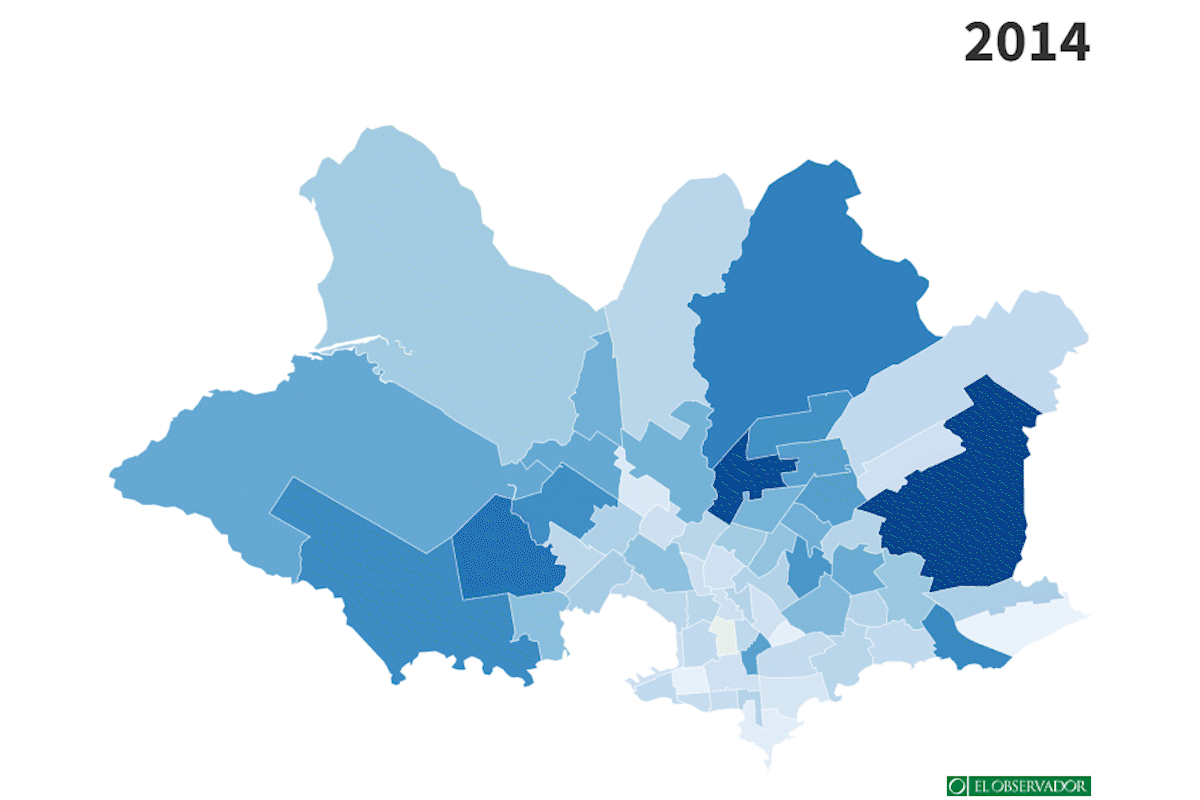in these july vacation there are fewer children taking advantage of their break. At least compared to a few years ago. On the second Sunday in August, Children’s Day, there will be fewer children showing off their bicycles, musical instruments or remote-controlled cars. On October 31st, Halloween, there will be fewer little ones collecting candy shouting trick-or-treating. The next football classic will have fewer pets. Fewer will be those who slide with cardboard from the quarries of Parque Rodó and those who wake up with lagañas at the time of going to school. Because Montevideolike Uruguay, it is emptying of children.
Children under five years of age, who less than a decade ago were more than 10% of the population of Casavalle or of the Wetlands of Carrasco, now they are about 6% of the inhabitants of these neighborhoods. And in some of the oldest areas of the capital, such as Fat tip either three crossesthe proportion of boys plummeted to about 4%.
The Observedr analyzed how the percentage of children has been falling in each neighborhood of Montevideo. The study —which had the technical advice of the director of Normalization and Research of the National Institute of Statistics of Uruguay, the statistician Juan Pablo Ferreira, and the demographer Ignacio Pardo of the Udelar Population Program— took as base information the Continuous Household Survey of the last ten years. And the result puts on a map what the experts have been pointing out: that Uruguay is one of the oldest countries region of. Not only because Uruguayans live, on average, more years, but because they have fewer and fewer children.
Last year, for the first time since there are records, more people died in Uruguay than were born. In part it was because deaths grew (covid-19 through), and, to a large extent, because the number of live births continues to decline: there were less than 35,000 or, what is the same, less than 1.4 children per woman at the age of being a mother.
That milestone is new, not so the drop in birth rate. When the Uruguayans came out to their main avenue to celebrate the maracanazoin 1950, in Latin America, women of childbearing age had, on average, six children. In almost all the countries of the region, the population pyramid was “perfect”, with a very wide base and a very extreme peak, like those of Egypt. There were many children and few adults. In Uruguay, on the other hand, women already had an average of three children already down. Little by little the pyramid was widening in the Middle Ages, looking like a rhombus like European societies.
“Uruguay began the demographic transition before the rest of the region. Already at the end of the 19th century, a decline in mortality began, which was followed, as expected, by a drop in fertility”, says the demographer Pardo.
Why did this happen? The countryside, where there is a greater incentive to have children, began to depopulate earlier. European immigrants got off the boats with the ideas of the Old Continent, in which women gave way to work and study (no longer just staying at home). And since Uruguay was a more developed country than its peers in the region —in times of fat cows and Switzerland of America—, the population pyramid became Europeanized.
But inside the Uruguayan territory the differences continued (continue). Montevideo, with its richest neighborhoods in the southeast coast and the poorest in the center-north, accounted for that heterogeneity.
Pardo explains that “in the poorest neighborhoods, people have, on average, more children and, at the same time, live fewer years”. A study in Madrid, the Spanish capital, showed that those born in the most disadvantaged areas lived eight years less than those born in the wealthiest regions.
On the other hand, in the wealthiest neighborhoods, families take accounts of the cost-benefit to have a child at a certain time: will I be able to support it? Can I go out to study? If I study before, will I have a better salary? “In the poorest neighborhoods, it is also about decisions with a rational calculation component, but the opportunity cost of having children is lower, because it is very likely that access to employment will be in worse conditions and with worse pay,” says Pardo. . And, as if that were not enough, access and contraceptive policy they were turned in favor of those who live southeast of the capital.
But that is changing. In the past six years, the number of live births has fallen at a rate that demographers weren’t even projecting for after 2050. More than a half (52%) of the drop in births is explained by the drop in pregnancy in adolescents and young people, which was concentrated, above all, in the poorest areas. Hence, in neighborhoods like Casavalle —where six out of every ten inhabitants have at least one unsatisfied basic need according to the last census— has seen this notable depletion of children.
Jasmine knows it even under the skin. In his left arm and out of sight, thinner and smaller than a toothpick, lies the reason why this teenager from the west of the capital put an end to an inheritance that burdened her family. Her mother had given birth to her when she was only 16 years old. Her grandmother had also begun motherhood around 15, and her great-grandmother, and her great-great-grandmother. But long-acting contraceptionthat subdermal implant that was placed at no cost to the Uruguayan teenager, changed destiny.
At the population level, this decrease in the fertility of the youngest has brought the indicators to such low levels that, according to Pardo, “a rebound effect to levels not so low in the coming years is highly expected.”
But for the pyramid of the poorest neighborhoods to change completely, and look more like a rectangle than that of Giza, it is missing. In Montevideo, as in Uruguay, the older ones continue to be concentrated in a few neighborhoods.
What are the oldest neighborhoods?
The Old City is getting older. The area that concentrates the most historical monuments is the neighborhood with the fewest children under five (only 3.3%). And little by little scale between the oldest neighborhoods.
But residential areas, like Diving, Pocitos either Punta Carretas They are the largest percentages of older people —as they are called, if it is politically correct, those over 65 years of age. In any of these three neighborhoods in the southeast, one in five residents is already considered an older adult (even though Pocitos, with its almost 80,000 residents, is the most densely populated neighborhood).
The health emergency left a postcard that seemed inevitable: several hotels converted into residences for adults. Because although in Uruguay the percentage of elderly people who are institutionalizedmore and more veterans require care.
People of retirement age are already more than those under 15 years of age. That is one of the indicators that was most debated in the expert commission that thought about the social security reform. But outside of that “economist” view of old age, specialists warn that Montevideo (like big cities) will have to rethink: Is it adapted for the most adults?
In the Municipality E, where there are neighborhoods such as La Unión with more than 17% of its population over 65 years of age, the residents have, on average, a polyclinic 31 blocks away. In the CH municipality, on the other hand, that distance shrinks to 11 blocks. The data “seem to show us that there is a state but whose presence, depending on the place, is tenuous,” warned researcher Gonzalo Bustillo, who led the study of distance to services by the Faculty of Architecture of the Udelar.
This need for adaptation of the city tends to be more pressing in those neighborhoods that concentrate the oldest population within the older adults.
What neighborhoods concentrate more older adults among the older population?
The southern and eastern coast is, once again, the most overaged region of Montevideo. This is what the technicians call the areas where the population over 84 years has a greater weight among the elderly (the population over 65 years). More than a fifth of the older adults in Punta Gorda, Tres Cruces and Parque Rodó are in their eighties, nineties or centenarians.
The Meadowwhere the Uruguayan aristocracy had built their large country houses more than a century ago, slips into the top 5 of over-aged neighborhoods: one in five older adults is also over 84 years old there.
At the opposite extreme are some of the neighborhoods that have more children, such as Bañados de Carrasco, Villa García, Casavalle and La Paloma. So few old people Casabo, one of the ten most populous neighborhoods in the capital, has less than 400 people over 84 years of age. This phenomenon, says the demographer Pardo, “is not only explained by the fact that people live for fewer years in the poorest areas, but also by the high fertility of these areas, which means that the rest of the ages have less relative weight. The other factor that affects the age composition of a territory is residential mobility patterns, when those who enter or leave a neighborhood have a certain age profile. For example, when older people tend to move to another neighborhood.

















